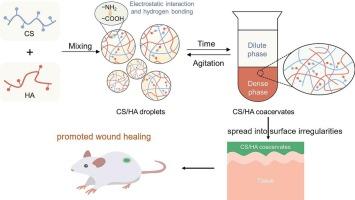Development of low-molecular-weight polysaccharide-based wound dressings for full-thickness cutaneous wound healing via coacervate formation
IF 10.7
1区 化学
Q1 CHEMISTRY, APPLIED
引用次数: 0
Abstract
The development of polysaccharide-based wound dressings that are easy to prepare, adhere to tissue, adapt to diverse shapes and exhibit tunable mechanical properties holds significant clinical interest. This study introduced a simple spontaneous liquid-liquid phase separation technique employing low-molecular-weight and high polyion concentration of chitosan (CS) and hyaluronic acid (HA) to fabricate CS/HA coacervates. Upon increasing the molecular weight of chitosan from 7 kDa to 250 kDa, a transition in the CS/HA coacervates from liquid-like state to an elastic liquid and eventually to a solid-like state was observed. The resulting CS/HA coacervates demonstrated robust water resistance and adhesion to skin tissue. Notably, the molecular weight of chitosan significantly influenced the mechanical properties and hydration levels of the CS/HA coacervates. Moreover, in vivo studies using a full-thickness cutaneous defect model revealed that the CS/HA coacervates, prepared using 100 kDa chitosan, markedly accelerate wound healing. The coacervates' ease of preparation, wet adhesion, heterogeneous structure, suitability for irregularly shaped wounds, and exceptional wound healing promotion of the coacervates qualify them as an optimal wound dressing.

开发基于低分子量多糖的伤口敷料,通过形成凝聚剂促进全厚皮肤伤口愈合
多糖类伤口敷料易于制备、能粘附组织、适应各种形状并具有可调的机械性能,这种敷料的开发具有重大的临床意义。本研究采用一种简单的自发液-液相分离技术,利用低分子量、高聚离子浓度的壳聚糖(CS)和透明质酸(HA)来制造 CS/HA 共凝胶。当壳聚糖的分子量从 7 kDa 增加到 250 kDa 时,观察到 CS/HA 共凝胶从液态转变为弹性液体,并最终转变为固态。由此产生的 CS/HA 共凝胶具有很强的耐水性和对皮肤组织的粘附性。值得注意的是,壳聚糖的分子量会显著影响 CS/HA 共凝胶的机械性能和水合水平。此外,使用全厚皮肤缺损模型进行的体内研究表明,使用 100 kDa 壳聚糖制备的 CS/HA 共凝胶能明显加速伤口愈合。这种共凝胶易于制备、具有湿粘附性、异质结构、适用于不规则形状的伤口,而且对伤口愈合有显著的促进作用,因此是一种理想的伤口敷料。
本文章由计算机程序翻译,如有差异,请以英文原文为准。
求助全文
约1分钟内获得全文
求助全文
来源期刊

Carbohydrate Polymers
化学-高分子科学
CiteScore
22.40
自引率
8.00%
发文量
1286
审稿时长
47 days
期刊介绍:
Carbohydrate Polymers stands as a prominent journal in the glycoscience field, dedicated to exploring and harnessing the potential of polysaccharides with applications spanning bioenergy, bioplastics, biomaterials, biorefining, chemistry, drug delivery, food, health, nanotechnology, packaging, paper, pharmaceuticals, medicine, oil recovery, textiles, tissue engineering, wood, and various aspects of glycoscience.
The journal emphasizes the central role of well-characterized carbohydrate polymers, highlighting their significance as the primary focus rather than a peripheral topic. Each paper must prominently feature at least one named carbohydrate polymer, evident in both citation and title, with a commitment to innovative research that advances scientific knowledge.
 求助内容:
求助内容: 应助结果提醒方式:
应助结果提醒方式:


